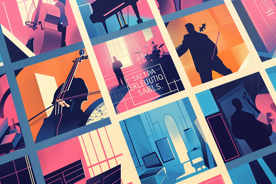Mussorgsky: Pictures at an Exhibition
Catalog Number: 902096DI
- Pictures at an Exhibition
- 1. Promenade. I. The gnome
- 2. Promenade. II. The old castle
- 3. Promenade. III. The Tuileries Gardens (Children quarrelling after playing)
- 4. IV. Bydlo.
- 5. Promenade. V. Ballet of the unhatched chicks
- 6. VI. "Samuel" Goldenberg und "Schmüyle".
- 7. Promenade. VII. The marketplace in Limoges
- 8. VIII. The catacombs
- 9. With the dead in a dead language (Promenade). IX.The hut on fowl's legs (Baba Yaga)
- 10. X. The great gate of Kiev
- Fantasie in C major, Op. 17
- 11. I. Durchaus phantastisch und leidenschaftlich vorzutragen
- 12. II. Mäßig. Durchaus energisch
- 13. III. Langsam getragen. Durchweg leise zu halten
‘Music is never about things.
Music just is’, Leonard Bernstein once said.
Perhaps that was why Schumann decided to remove the evocative titles (‘Ruin, Triumphal Arch, Constellation’) from his Fantasie: the music has an independent existence without them.
Is the same true of Pictures at an Exhibition?
Mussorgsky created here something subtler and more ambivalent than Hartmann’s paintings might suggest.
Alongside the dazzling virtuosity they call for, Paul Lewis’s unexpected coupling reveals the purely musical qualities of these two 19th-century masterpieces. “La musique ne décrit jamais les choses.
La musique ne fait qu’exister”, dixit Leonard Bernstein.
C’est peut-être pour cette raison que Schumann décida de supprimer de sa Fantasie les titres évocateurs initialement prévus (“Ruine, Arc de triomphe, Constellation”) : la musique possède une existence autonome sans ceux-ci.
Mais n’en va-t-il pas de même des Tableaux d’une exposition ?
Moussorgski crée ici quelque chose de plus subtil et de plus ambivalent que ne pouvaient le suggérer les peintures de Hartmann.
Outre la virtuosité éclatante qu’ils exigent, ce couplage inattendu proposé par Paul Lewis révèle les qualités purement musicales de ces deux chefs-d’œuvre du xixe siècle. „Musik beschreibt nie Dinge.
Musik ist einfach“, sagte Leonard Bernstein einmal.
Vielleicht war das auch der Grund für Schumann, die hinweisenden Titel („Ruine, Siegesbogen, Sternbild“), die er ursprünglich für seine Fantasie vorgesehen hatte, zu verwerfen: Die Musik besitzt ihre eigene Autonomie ganz ohne sie.
Aber gilt das auch für die Bilder einer Ausstellung?
Mussorgsky schuf hier etwas Subtileres und Ambivalenteres als die Bilder von Hartmann je hervorrufen konnten.
Neben ihrer ungeheuren Virtuosität enthüllt Paul Lewis‘ ungewöhnliche Kopplung vor allem die rein musikalischen Qualitäten dieser beiden Meisterwerke des 19.
Jahrhunderts.
Made in Sweden since 1999. In collaboration with Textalk.
Cart
| Artikel | Antal | Beskrivning | a pris | Totalt |
Env.session: NULL Env.order NULL string(2) "en" collector.CheckoutUrl collector.OrderItemCount 0 collector.CartUrl NULL collector.Order NULL


